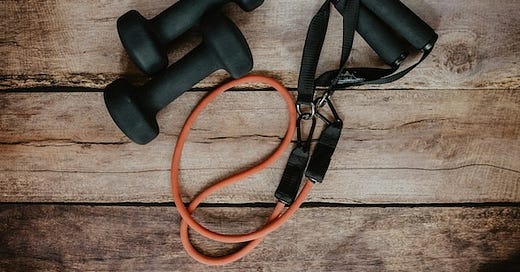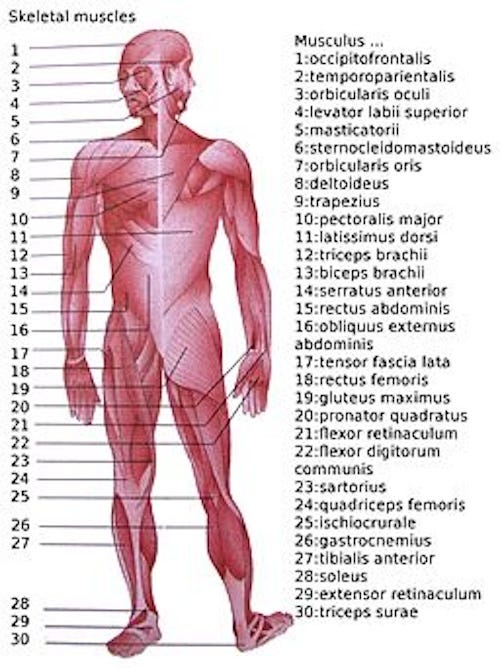Quick Pop Quiz
How many muscles are in the human body?
What is the largest muscle in the human body?
What is the smallest muscle in the human body?
What is the strongest muscle in the human body?
What attaches our muscles to our bones?
(Answers at the end of the post.)
The past two years have been some of the most physically painful of my life, and most of the pain was muscular. Dr. Google helped me incorrectly self-diagnose my complaints and their causes (you have to wonder how often health practitioners hear, “I looked it up online and …”). An x-ray helped to explain that arthritis was one small source of my pain. Physical therapy helped me to understand that despite my daily commitment to daily walking, weekly yoga, and occasional strength training, most of my larger muscles were weak and not doing their share of the daily work of keeping me moving. Smaller muscles had to pick up the slack, and eventually, they had enough and rebelled.
Muscular pain is the most common health issue people report as they age. Muscles help us maintain balance, stabilize our bodies, and support our posture throughout our lives. Our muscular system is key to maintaining our physical independence as we age.
I suspect that most of us take our muscular system for granted until it hurts or stops working as expected. Consider how muscles quietly keep us going:
Breathing
Speaking
Eating, drinking, swallowing, digesting & eliminating
Seeing & hearing
Pumping blood throughout our body (See my Aging Heart post)
Moving, sitting, standing upright, keeping our big heads upright
Generating heat and energy as part of our metabolism
And…a majority of us were born with the help of some powerful abdominal muscles!
I’ve Fallen and Can’t Get Up
Culturally, we have accepted that weak muscles are part of aging. Think about how older people are pictured: stooped over, shuffling in small steps, and in a well-known TV commercial, an older person who can’t get up after falling. Those images exist because they are the reality for many older people. The question is how much is caused by a natural decline as we age and how much results from underuse and inactivity.
A healthy and fit muscular system is key to maintaining our physical independence as we age.
Muscles lose mass, strength, and function as we age, a natural process called sarcopenia. Symptoms include fatigue, weakness, and loss of stamina. We naturally begin losing muscle mass in our 30s, continue the decline at 3%- 5% of muscle mass per decade, and then the decline rate increases to 1%- 2% annually after age 50. Without preventative strategies, sarcopenia happens faster as we move into our 70s and dramatically increases the risks of falls and injuries. In our older years, our muscle tissue is replaced with tough fibrous tissue, resulting in muscles that are less toned, less flexible, and less able to contract.
Other contributing factors can include hormonal changes, a decline in the body’s ability to convert protein to energy, a reduction of nerve cells that message our muscles to move, and insufficient calories and protein to support the growth of new muscle tissue. Sarcopenia is also associated with obesity, type 2 diabetes, and high blood pressure.
Grip Strength as a Biomarker
Research indicates that a simple measurement of hand, wrist, and forearm strength can assess our overall health. Our grip strength begins to decline after age 50, but active use of our muscles slows the decline. As a biomarker, our grip strength can reflect the health of our entire muscular system, our immune system, our risk of chronic disease, and our mental health. Weak muscles limit our activities, so we become more sedentary, which, in turn, weakens our immune system, setting us up for chronic diseases. Reduced mobility often means less interaction with friends and family, leading to loneliness and isolation. Reduced grip strength is considered a sign of frailty. The 10-minute video below offers 5 simple exercises you can easily fit into your day.
That’s the bad news about our aging muscles, but the good news is that we can prevent or treat sarcopenia by adopting a resistance (AKA strength) training program in addition to our daily walks and other cardio exercise. It’s estimated that less than 25% of people over age 65 consistently perform strength training with weights or resistance bands twice weekly. Consistent effort is necessary as muscles lose toning and strength if training stops.
Strength preservation [training] is the most important thing one can do when they pass their 50th birthday. ~ Dr. Mark Peterson, University of Michigan
The best news is that it is never too late. Even if you’ve never lifted a dumbbell or set foot in a gym, you can still build muscle in middle age and later in life. (A 2011 meta-analysis found that subjects over 50 who started a consistent weightlifting program increased their muscle mass by an average of almost 2.5 pounds in only five months, roughly half of what they might have accomplished earlier in life.) The secret to building healthy muscle is to gradually increase the weight you lift, the repetitions, and the sets (i.e., groups of repetitions) over time.
Tips for Starting Resistance Training
If you have health concerns, always check with your primary healthcare practitioner before introducing new exercises to your physical wellness routine.
If you can afford it, invest in several sessions with a fitness coach who is trained or experienced in working with older people. They can design routines for use in a gym or at home.
Developing a home practice takes a daily commitment to make it a habit. There are many YouTube videos to follow, but if you are over age 50, I encourage you to look for video classes that are specific to older people. Set up a space with equipment ready for use. Keep a daily record of activities.
I recommend Senior Shape Fitness on YouTube (No financial affiliation with her.) I have utilized her videos for the last 18 months and love the diversity of workouts. Rather than pushing us to go faster or keep up (as many of the younger fitness instructors do), she encourages us to listen to our bodies: her motto is “You do You.”
Be sure you are doing the exercises correctly; poor or incorrect form can cause injury. The American Council on Exercise has an Exercise Library of exercises with photos and how-to descriptions.
Start training 2x a week, gradually increasing weight and reps. Routines that alter the lower body with upper body exercises or compound sets are important to overall fitness.
Once a day, do a series of hand-strengthening exercises.
Increase your protein intake to 30 grams at each meal.
Pop Quiz Answers
The human body has more than 600 muscles.
The largest muscle in the human body is the gluteus maximus (and its two companion muscles, the medius and the minimus), which reside behind the hips. Many of us spend a lot of time sitting on our glutes. The glutes are responsible for keeping our bodies upright and for most of our lower body movement, including climbing stairs, getting out of chairs, and pushing a wheelbarrow around the garden.
The two smallest muscles in the inner ear connect to the eardrum, which also has the smallest bone in the body.
The masseter muscle in our jaw is the strongest in our body.
Tendons attach our muscles to our bones. Ligaments connect our bones to our joints.
Next in the Aging Body Series: Balance, Flexibility, Stretching & Developing a Home-Based Exercise Routine
Thank you for being here. All of my posts are free, but if you’d like to support my work, you can do so by:
Liking and restacking this post so others are encouraged to read it.
Share this post via email or on social media.
Taking out a paid subscription to this Substack.
Please share your thoughts, tips, experiences, and recommendations in the comments.







Find a CrossFit gym that welcomes seniors, attend regularly, understand that every movement can be scaled to any ability level. Started at 58, now 73, have had fun all the way.
What are your thoughts on attention to posture and walking energetically, taking stairs when possible, and building flexibility and balance into common movements. I am 68 yr old female skier, paddler, gravel rider, and hiker. I watch how people move and notice a steep drop off of vigor in folks over 50. My 86 yr old MIL is in Assisted Living and visits there are a reminder of what’s at stake. She decided at 80, that she was done moving her body and decided to take it easy. With 6 months, she lost her ability to live independently. Sarcopenia has whittled her down to 110# and bent over a walker.